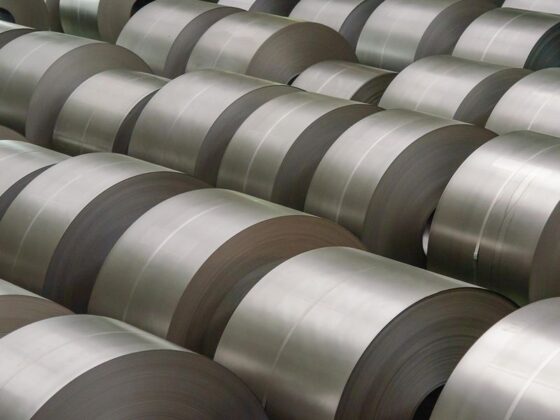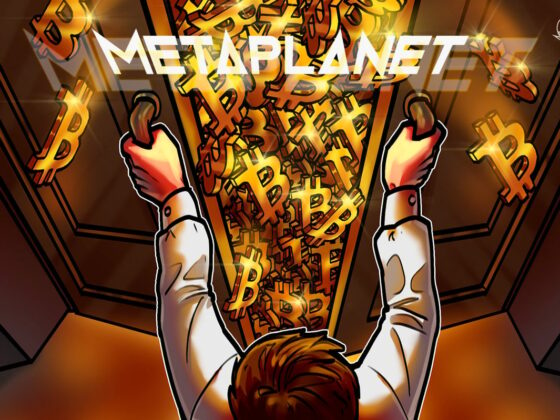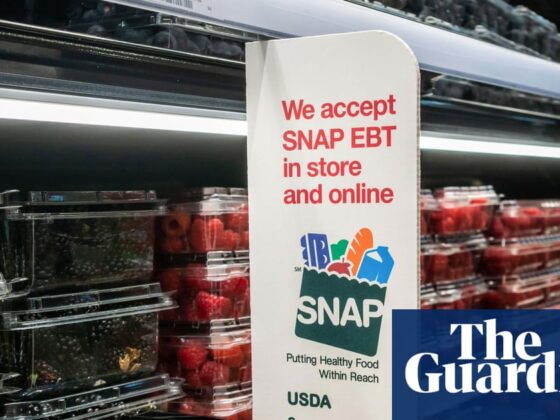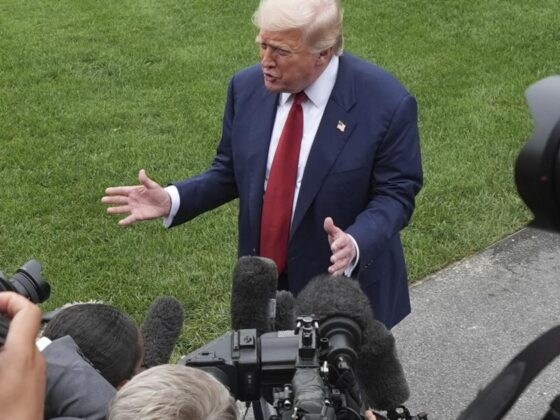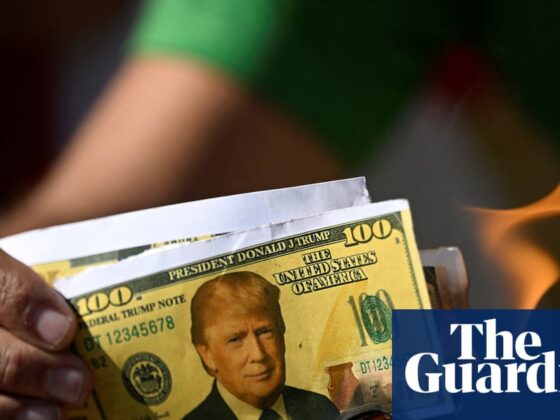A summary
A quick recap.
Stock markets in Europe and across Asia-Pacific countries have fallen after Donald Trump announced new tariffs on dozens of US trading partners.
Last night, as the latest deadline to reach deals approached, Trump signed an executive order imposing tariffs ranging from 10% to 41%.
Rates were set at 25% for India, 20% for Taiwan and 30% for South Africa ahead of Trump’s self-imposed deadline of 1 August for striking trade deals with countries worldwide.
Trump also extended the deadline for a tariff agreement with Mexico by another 90 days.
Share prices have weakened in response – with Germany’s DAX down 1.9% and France’s CAC losing 2.2%, as European stock markets fell to a one-month low.
Asia-Pacific stock markets were on track for their worst week since April, with Japan’s Nikkei 225 losing 0.6%,
South Africa’s stock market is now down almost 1.5%.
And there was shock in Switzerland, which has been lumbered with a 39% tariff rate – which manufacturers fear will lead to job losses.
Key events
Donald Trump’s tariff playbook is becoming clearer following last night’s announcement, says Paul Diggle, chief economist at Aberdeen Investments.
This playbook consists of:
-
A 10% global baseline tariff
-
A rate of at least 15% on countries with goods trade deficits with the US
-
An additional 40% on goods transhipped to evade higher rates elsewhere
-
A variety of new country-specific rates on smaller trading partners, such as 20% on Taiwan or 39% on Switzerland
-
Trump has also announced a 35% tariff on Canada, although the carve-out for USMCA-compliant trade remains [that’s the United States-Mexico-Canada Agreement]
Diggle adds that there are still plenty of uncertainties, including where US-China tariffs settle….
Last night’s tariff announcement contained some good news for the African country of Lesotho.
Donald Trump has lowered Lesotho’s tariff rate to 15%, having previously threatened it with a 50% rate.
That should make it easier for manufacturers in Lesotho – which last month declared a national state of disaster over the country’s “high rates of youth unemployment and job losses” – to sell their goods to American consumers.
The BBC reported earlier this week that a Lesotho garment factory, which has produced Trump-branded golf shirts, was at risk of shutting down due to the high tariffs….
A summary
A quick recap.
Stock markets in Europe and across Asia-Pacific countries have fallen after Donald Trump announced new tariffs on dozens of US trading partners.
Last night, as the latest deadline to reach deals approached, Trump signed an executive order imposing tariffs ranging from 10% to 41%.
Rates were set at 25% for India, 20% for Taiwan and 30% for South Africa ahead of Trump’s self-imposed deadline of 1 August for striking trade deals with countries worldwide.
Trump also extended the deadline for a tariff agreement with Mexico by another 90 days.
Share prices have weakened in response – with Germany’s DAX down 1.9% and France’s CAC losing 2.2%, as European stock markets fell to a one-month low.
Asia-Pacific stock markets were on track for their worst week since April, with Japan’s Nikkei 225 losing 0.6%,
South Africa’s stock market is now down almost 1.5%.
And there was shock in Switzerland, which has been lumbered with a 39% tariff rate – which manufacturers fear will lead to job losses.
European selloff deepens
The European stock market selloff is gathering pace.
After a volatile morning, Germany’s DAX index and Italy’s FTSE MIB are both down 1.9% while France’s CAC has lost 2.3%.
Joshua Mahony, chief market analyst at financial services group Rostro, reports that sentiment in the markets has ‘soured’ after last night’s tariff announcements from the White House.
Global markets are heading lower as we close out a week of major volatility, with a raft of corporate, economic, central bank, and trade headlines hitting the newswires on a daily basis. For the most part we have seen the strength of US tech earnings and positive trade agreements helping to prop up market sentiment for many markets, although that strength has started to falter as risks grow. With the DAX falling to the lowest level in a month, we have clearly started to see sentiment sour after relative stability.
The announcement of tariff levels across the globe has provided a follow up to the initial ‘Liberation Day’ cardboard cutout, with the new levels providing many with lower tariffs than had initially been set out. Notably, those rates come into play in a weeks’ time, providing hope for those seeking fresh trade agreements before the heftier tax levels come into play.
Many companies will be confused about how the new US tariffs apply to them, warns Andrew Wilson, deputy secretary-general of the International Chamber of Commerce (ICC).
Wilson explains:
“At a macro level, last night’s announcement provides confirmation that the administration is set on applying generally higher tariff rates. So, the TACO logic seems to be off the menu.
But at a more practical level, we still see companies struggling to understand how the country specific rates will apply in practice.
The Executive Order (EO) only states the headline tariff rate, with no specifics as regards their implementation aside from the EU deal.
As such, there are still widespread questions about which tariffs will stack — the Japan deal for instance is notably silent on this issue compared to the EU agreement.
So, clarity on the direction of travel. But many questions remain about implementation and the real world implications.”
As an example, the information released by the White House last night showed that Brazil now faced a tariff of 10%. However, on Wednesday Trump signed an executive order confirming that the US would impose 50% tariffs on Brazil.
And as my colleague Lisa O’Carroll explained in her earlier post, the European Union’s trade deal with the US (a 15% tariff, agreed last weekend) is not stacked on top of a pre-existing tariff, meaning it’s a better deal than many other countries.
The US dollar has hit its highest level in two months against a basket of currencies today.
The dollar index has risen by 0.1%, on track for its seventh daily rise in a row.
Traders may be calculating that Trump’s tariffs will be inflationary, pushing prices paid by consumers and making it harder for the US Federal Reserve to lower interest rates. They could also be factoring in the damage that the trade war will do to other countries, which could force their central banks to keep interest rates lower.
Job loss fears over Swiss tariffs
Donald Trump’s decision to hit Switzerland with a 39% tariff rate has caused shock in the markets, and in the Swiss Confederation.
Swiss president Karin Keller-Sutter posted on X last night that she spoke to Donald Trump on Thursday, but that the two country’s hadn’t reached an agreement.
She explained:
I had a final conversation today with US President Trump before the deadline for US tariffs expires. For the President, the trade deficit is the main focus. No agreement could be reached on the letter of intent negotiated between Switzerland and the USA.
The Swiss government says (see earlier post) it “continues to strive for a negotiated solution” over a tariff announcement which it “notes with regret”; manufacturers are warning that jobs are at risk.
Stefan Brupbacher, director of manufacturers’ association Swissmem, said:
“I am stunned. These tariffs are based on no rational basis and are arbitrary.
“This decision puts tens of thousands of jobs in the industry at risk.”
Swissmechanic, an industry lobby group, called the 39% rate “dangerous.”
It urged the government to keep negotiating in the remaining time until the tariffs are set to come into effect on 7 August, which otherwise risks leaving the economy becoming “one of the few countries that permanently struggle with structural competitive disadvantages”, Bloomberg reports.
As flagged earlier, shares in Watches of Switzerland have fallen sharply in London – they’re now down almost 9%.
Kathleen Brooks, research director at XTB, says Switzerland got the rough end of Trump’s trade war, explaining:
The Swiss rate was a shock, and the Swiss government have said that they plan to keep negotiating with the US to secure a lower levy. Chocolatiers, watch makers and pharma companies are all under threat. Pharma accounts for 50% of Swiss exports to the US. Swiss pharma giant Novartis’s share price is lower by 2% today, while Roche is lower more than 3% on Friday. Swiss pharma giants are also pressured by Trump’s campaign to force drug makers to charge lower prices for US consumers and demanding that they charge the same rate for the US as they do for other countries.
Switzerland will hope to secure the same rate as the EU, but time is running out. It appears that Switzerland may have been punished more than elsewhere because of the Swiss government’s desire to protect its openness, and to protect its domestic agriculture. Although it had said it was willing to lower import rates for fruit, nuts, shellfish and some medical devices, this was not enough for the US.
Today’s selloff has dragged European stock markets down to a one-month low.
The pan-European Stoxx 600 index is now down 1.1% at its lowest level since late June.
European pharmaceuticals stocks have dropped after Donald Trump wrote to executives at 17 companies on Thursday, demanding they match their US prices for prescription drugs with the lowest price offered in other developed nations.
Taiwan’s government is hoping that it can negotiate its new US tariff down, before the new deadline of 7 August.
Taiwanese president Lai Ching-te said today that the new 20% tariff rate set by the Trump administration on goods imported from the island is “temporary”, and the government expects to negotiate a lower figure.
Lai also noted that rates for semiconductors, electronics as well as information and communication technology will be subject to separate U.S. sectoral tariffs and are still to be worked out.
Lai told a press briefing:
“The 20% tariff rate was never Taiwan’s target to begin with. We will continue negotiations and strive for a rate that’s more favourable for Taiwan.”
French wine exporters see €1bn losses from Trump tariff
France’s wine and spirits industry expects to lose €1bn should the US go ahead with imposing a 15% import tariff on their products next week, as the European Union makes a last-ditch effort to obtain an exemption, Bloomberg reports.
The levy, due to come into force on 7 August, will likely cut a quarter of France’s annual exports from the sector, the country’s federation of wine and spirit exporters FEVS said in a statement on Friday.
It will also jeopardize the jobs of the 600,000 people directly employed by the industry, they fear.
FEVS President Gabriel Picard said:
“We welcome the efforts already made to try to obtain the exclusion of wines and spirits from this 15% duty.
“The situation cannot remain as it is. It is vital that France and the European Union actively engage with us to very concretely support our sector.”
Trump’s tariffs are a huge blow to global commerce, warns Atakan Bakiskan, US economist at Berenberg bank.
Bakiskan’s verdict is that that the situation is bad, but could have been even worse, explaining:
The tariffs distort competition between companies that produce in the US to serve the US market relative to those that produce abroad. But many European, Japanese and South Korean-based producers compete more against each other than against US-based producers in the US market.
As they all face a 15% levy, the competition between them is distorted by less than would have been the case if Trump had imposed widely different country-specific US tariffs against these key advanced economies.




